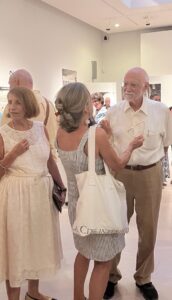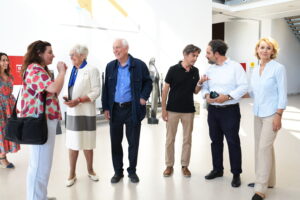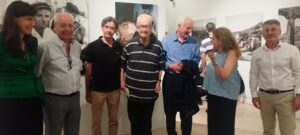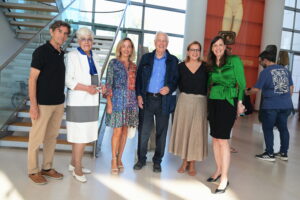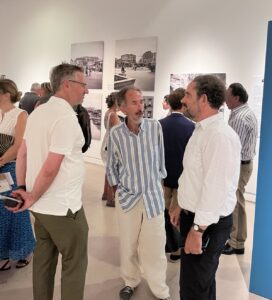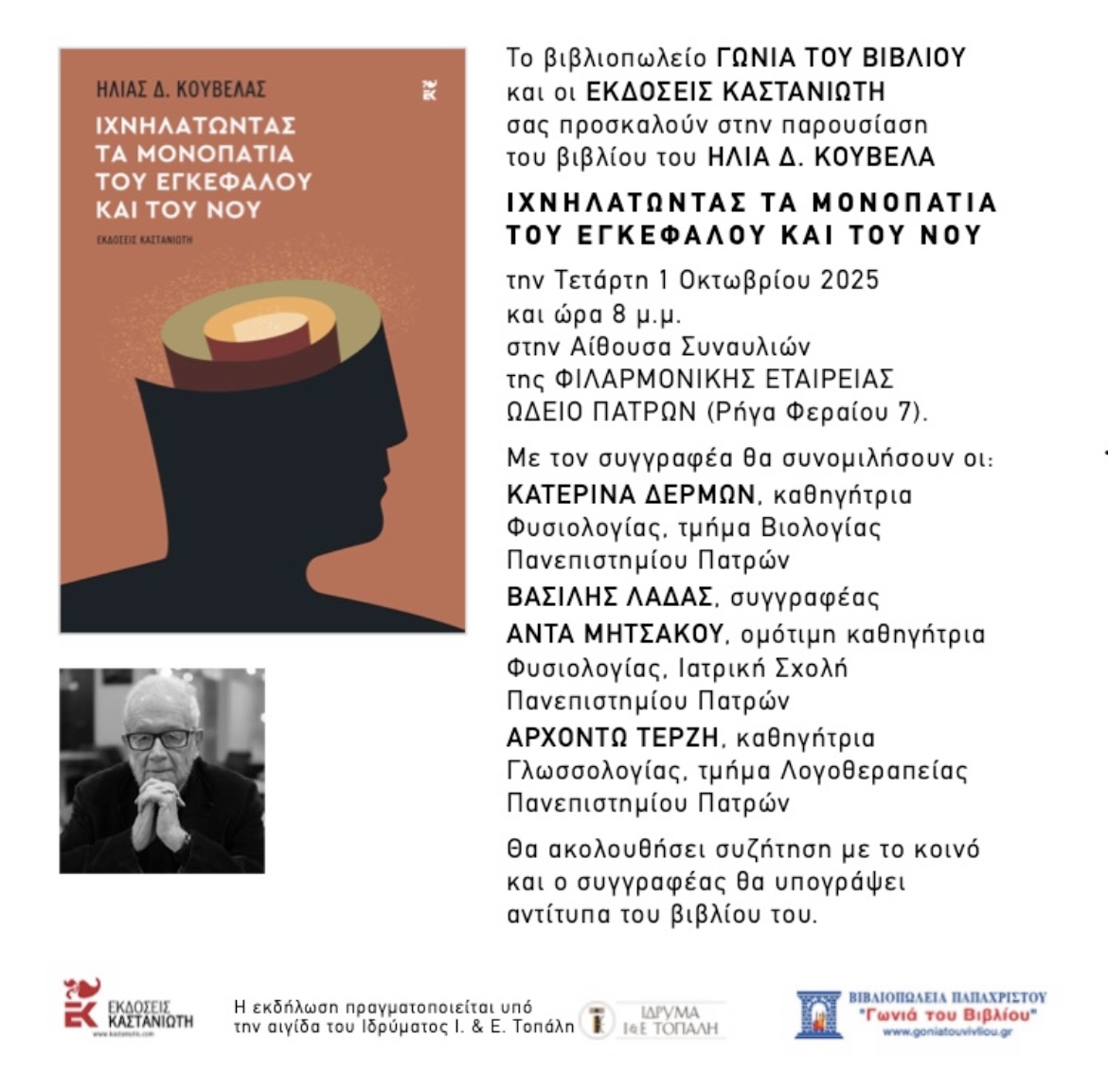
Press Release: Inauguration of Photography Exhibition and Presentation of the Album “GREECE AFTER THE WAR – The Years of Hope” by Robert McCabe at the Archaeological Museum of Patras
Share to 
With great success, on Friday, July 4th, the photography exhibition of the philhellene Robert McCabe, “GREECE AFTER THE WAR – The Years of Hope,” was held by the Ioannis and Euterpi Topalis Foundation, co-organized with the National Historical Museum and the Achaia Ephorate of Antiquities. Alongside the exhibition, the presentation of the album of the same title by Patakis Publications took place, featuring texts by Robert McCabe, Panagiotis Roilos, Harvard professor and holder of the Chair of Modern Greek Studies “Giorgos Seferis,” and Katerina Lymberopoulou, journalist.

In the packed auditorium of the Archaeological Museum of Patras, the album was presented by a multitude of personalities.

Greetings were delivered by the Deputy Minister of Culture, Iason Fotilas; the archaeologist and one of the exhibition’s curators, Giannis Moschos, on behalf of the Head of the Ephorate of Antiquities of Achaia, Anastasia Koumousi; the president of the Ioannis & Euterpi Topalis Foundation, Vangelis Politis Stergiou; the curator of permanent exhibitions at the National Historical Museum, Iphigenia Vogiatzis; and the Rector of the University of Patras, Professor Christos Bouras.
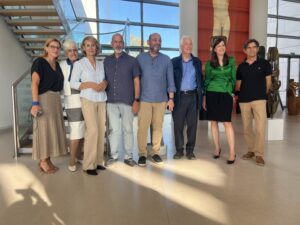
Next, the contributors of the album make explanations.

“The Greece of the 1950s was very different. Donkeys and mules were used everywhere. (The drivers jokingly said they would send the stubborn animals to Santorini — maybe they still say that.) Women washed clothes in rivers or near wells. They carried water to their homes with jugs or cans. Athens didn’t have traffic lights. Women often spun yarn, wove, or knitted. Men and women wore traditional clothes from their villages,” said Robert McCabe speaking in Greek, and he continued: “During our travels in those years — from Epirus to Crete, from Pylos to Rhodes — we were constantly surprised and delighted by the smiles, warmth, and hospitality of the Greeks. People who had lived through the war and hardships — but always welcomed us with kindness.”

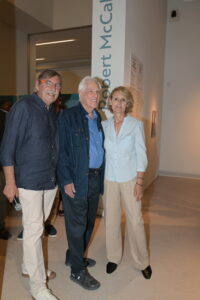

Panagiotis Roilos, after referring to the need for critical reflection on the major issues and unprecedented conditions of our highly transitional era, as well as on the new international institutions established or soon to be established at the European Cultural Centre of Delphi — where this exhibition was born — in his capacity as its president, noted:
“The discovery and development of photography redefined the concept, or even the very essence, of temporality. Photographers became the quintessential alchemists of modernity; privileged holders and guardians of a technologically advanced art that promised immortality.”
He concluded:
“In McCabe’s photographs, the traces (and ruins) of both the very distant and the very recent past coexist with promises of a slow rebuilding: mule drivers stand side by side with cars and trucks; traditional agricultural and trade practices alongside modern means of transportation; hand-painted cinema posters next to poorly dressed men; houses ruined by long-standing national disasters alongside neoclassical buildings and areas beginning to modernize.”
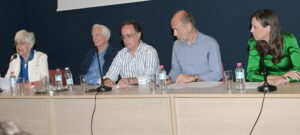
“Unforgettable was that meeting with Mrs. Athina Kakouri (notably, a collaborator of R. McCabe in his book Mycenae 1954: The Midday), in the small dining room of her apartment, where, among other things, seeing the photograph from Epidaurus in 1954, she recalled how, a year later, she made the journey from her city of Patras to there, so that her gaze would be haunted by a ‘cord’ of grieving women from nearby villages silently watching an ancient tragedy,” noted Katerina Lymberopoulou, speaking about the research she conducted in documenting Robert McCabe’s photographs.
She also mentioned those she met who offered historical knowledge and personal testimonies on behalf of the texts accompanying the new series of McCabe photographs, which enrich the exhibition of the same name at the Archaeological Museum of Patras. This series immortalizes the Rio-Antirrio ferry line when it was still in its infancy — notably, most of these images are being shown to the public for the first time.
As she explained, besides the aforementioned images, three new photographs from the Peloponnese — two of which are being publicly presented for the first time — are shown to the audience within the framework of this exhibition.
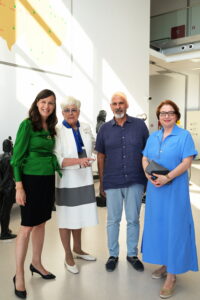
The speeches concluded with an analysis of the album by Konstantinos Ioannidis, associate professor at the Athens School of Fine Arts. He said:
“The book Greece After the War with photographs by Robert McCabe and texts by Panagiotis Roilos and Katerina Lymberopoulou is an outstanding book in many respects, which I will attempt to highlight. First of all, it is exceptional as a physical object: it is expertly crafted with carefully selected photographs that have been worked on (in the important stages of scanning and editing) with knowledge, sensitivity, and respect for the creator’s intentions. This is especially evident in the color material, which is based on the quality of Kodachrome films that retain their vibrancy decades later, but the choices made have achieved an enviable balance between a retro feel and a contemporary one. As for the black-and-white material, the balance is already secured by the negative but here it is between the timeless and the snapshot.”
The presentation was coordinated by Zetta Zachou, communications advisor.
Following this, the inauguration of Robert McCabe’s photo exhibition took place in the crowded temporary exhibition hall of the Archaeological Museum of Patras. This exhibition “visits” Patras after its first presentation, as previously mentioned, at the European Cultural Centre of Delphi, and subsequently traveled to Seoul, South Korea, and the Rizarios Exhibition Centre in Monodendri, Ioannina.
Apart from the aforementioned new series of Robert McCabe photographs of the Rio-Antirrio line — researched and accompanied by texts from Katerina Lymberopoulou — the exhibition bears the curatorial imprint of Dimitra Christodoulopoulou, art historian and curator, and Giannis Moschos, archaeologist and exhibition curator of the Archaeological Museum of Patras. It is further enriched by a contemporary artistic creation by visual artist Giannis Papadopoulos.
Finally, personal belongings of the photographer displayed in two vitrines complement the presentation in an experiential manner.


As visitors entered the Archaeological Museum, a special atmosphere was created by the jazz duo Spilios Kastanis on double bass and Vasilis Tziatzias on electric guitar. 
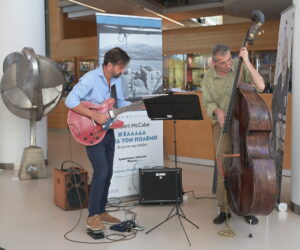
The exhibition, which will run until October 2025, is accompanied by a triptych with special emphasis on the Rio–Antirrio section.

The day after the exhibition’s opening, on Saturday, July 5th, during a scheduled visit of R. McCabe to the historic winery Achaia Clauss, a barrel of aged Mavrodaphne vintage was dedicated to him, which he signed, honoring his many years of contribution to our country.


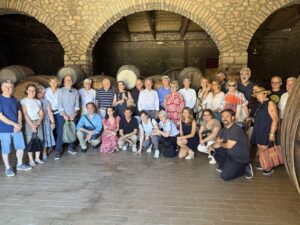
Exhibition Credits
ORGANIZATION
Ioannis & Euterpi Topalis Foundation
Ephorate of Antiquities of Achaia
National Historical Museum
RESEARCH – TEXTS
Panagiotis Roilos, Katerina Lymberopoulou
COORDINATION – ORGANIZATION – SUPERVISION
Vaggelis Politis Stergiou
EXHIBITION CURATION – DESIGN
Dimitra Christodoulopoulou, Giannis Moschos
ART INSTALLATION
Giannis Papadopoulos
COMMUNICATION CONSULTANT
Zetta Zachou
FINANCIAL MANAGEMENT
Ilias Bousias
TRANSLATIONS
Christina Theocharis, Alexandra Douma, Anne McCabe, Rhyme & Reason Language Services
PRINTING AND SCANNING
Giorgos Marinos and Sofia Panou, Idolo Fine Art Photolab
ALUMINUM PRINTS
Apolyto
DIGITAL PRINTS
Unitype
VISUAL IDENTITY & PRINT DESIGN
To Donti
SPECIALIZED ARTISANS, Ephorate of Antiquities of Achaia
Giannis Alexandropoulos, Mikes Merligas, Giannis Mitropoulos
With special thanks to:
Dr. Anastasia Koumousi, Head of Ephorate of Antiquities of Achaia
Iphigenia Vogiatzis, Curator of Permanent Exhibitions, National Historical Museum
for their invaluable contribution to the success of the event
Info:
Robert McCabe «Greece after the War – The Years of Hope»
Archaeological Museum of Patras
Until October 2025
ampatron.gr



